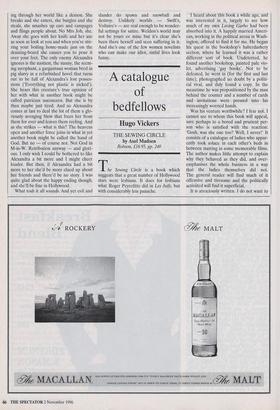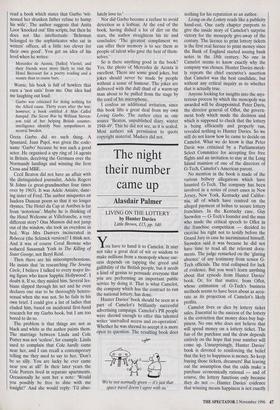A catalogue of bedfellows
Hugo Vickers
THE SEWING CIRCLE by Axel Madsen Robson, f16.95, pp. 240 The Sewing Circle is a book which suggests that a great number of Hollywood stars were lesbians. It does for lesbians what Roger Peyrefitte did in Les Jail's, but with considerably less panache. I heard about this book a while ago, and was interested in it, largely to see how much of my own Loving Garbo had been absorbed into it. A happily married Ameri- can, working in the political arena in Wash- ington, offered to find it for me. He began his quest in the bookshop's haberdashery section, where he learned it was a rather different sort of book. Undeterred, he found another bookshop, painted pale vio- let, advertising 'gay books'. Not to be defeated, he went in (for the first and last time), photographed no doubt by a politi- cal rival, and duly found a copy. In the meantime he was propositioned by the man behind the counter and a number of cards and invitations were pressed into his increasingly worried hands.
Was his venture worthwhile? I fear not. I cannot see to whom this book will appeal, save perhaps to a bored and prurient per- son who is satisfied with the reaction: `Gosh, was she one too? Well, I never!' It consists of a catalogue of ladies who appar- ently took solace in each other's beds in between starring in some memorable films. The author makes little attempt to explain why they behaved as they did, and over- emphasises the whole business in a way that the ladies themselves did not. The general reader will find much of it offensive and tiresome and the politically activated will find it superficial.
It is atrociously written. I do not want to read a book which states that Garbo 'wit- nessed her drunken father refuse to hump his wife'. The author suggests that Anita Loos 'knocked out' film scripts, but then he does not like intellectuals: `Behrman belonged to the sophisticates who sat in writers' offices, all a little too clever for their own good'. You get an idea of his level when he writes:
Mercedes de Acosta, [Salka] Viertel, and their friends were more likely to visit the Hotel Brevoort for a poetry reading and a seance than to cruise bars.
Worse, his book is full of howlers that earn a `non satis' from me. One idea had me laughing out loud: Garbo was criticised for doing nothing for the Allied cause. Thirty years after the war, however, a book entitled A Man Called Intrepid: The Secret War by William Steven- son told of her helping British counter- intelligence identify Nazi sympathisers in neutral Sweden.
Greta Garbo did no such thing. A Spaniard, Juan Pujol, was given the code- name 'Garbo' because he was such a good actor. He organised a spy ring of 14 agents in Britain, deceiving the Germans over the Normandy landings and winning the Iron Cross and MBE.
Cecil Beaton did not have an affair with the distinguished journalist, Adela Rogers St Johns (a great-grandmother four times over by 1963). It was Adele Astaire, danc- ing sister of Fred. The author misquotes an Isadora Duncan poem so that it no longer rhymes. The Hotel du Cap at Antibes is far from `notorious'. Maybe he is thinking of the Hotel Welcome at Villefranche, a very different story? Ona Munson did not jump out of the window, she took an overdose in bed. Was Mrs Danvers incinerated in Rebecca (the Selznick version)? I think not. And it was of course Coral Browne who seduced Susannah York in The Killing of Sister George, not Beryl Reid.
Then there are his miscomprehensions. He insists that 'in researching The Sewing Circle, I believe I talked to every major liv- ing figure who knew Sapphic Hollywood'. I doubt it. If so, they misled him. Several les- bians slipped through his net and he even declares one star to be thoroughly hetero- sexual when she was not. So he fails in his own brief. I could give a list of ladies that eluded him, based on incidental first-hand research for my Garbo book, but I am too bored to do so.
The problem is that things are not as black and white as the author paints them. The marriage between Linda and Cole Porter was not 'sexless', for example. Linda used to complain that Cole hardly came near her, and I can recall a contemporary telling me they used to say to her, 'Don't be so silly. You are lucky he ever came near you at all!' In their later years the Cole Porters lived in separate apartments. Occasionally he sent her a note: 'Would you possibly be free to dine with me tonight?' And she would reply: 'I'd abso- lutely love to.'
Nor did Garbo become a recluse to avoid detection as a lesbian. At the end of the book, having dished a lot of dirt on the stars, the author straightens his tie and concludes: 'The greatest compliment we can offer their memory is to see them as people of talent who gave the best of them- selves.'
So is there anything good in the book? Yes, the photo of Mercedes de Acosta is excellent. There are some good jokes, but jokes should never be made by people without a sense of humour. The jokes are delivered with the dull thud of a warm-up man about to be pulled from the stage by the cord of his microphone.
I confess an additional irritation, since this book lifts a great deal from my own Loving Garbo. The author cites as one source 'Beaton, unpublished diary, winter 1948-49'. This he did not see, as it is sealed. Most authors ask permission to quote copyright material. Madsen did not.



















































































 Previous page
Previous page